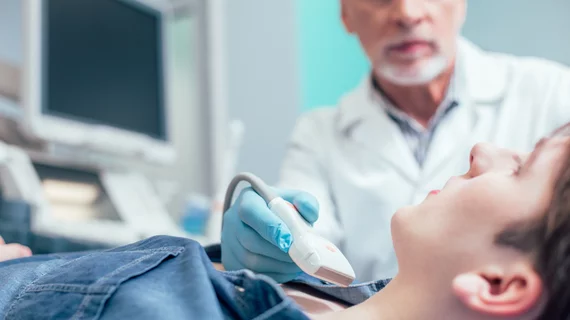TI-RADS could help guide thyroid nodule biopsy decisions in children
Compared to the overall impression of radiologists, the use of ACR’s Thyroid Imaging Reporting and Data System (ACR TI-RADS) and/or a deep learning algorithm could better determine the need for biopsy in children with thyroid nodules.
Radiologists’ impressions are most often the driving force behind biopsy referrals for thyroid nodules identified on ultrasound images. This is especially true in children, as ACR TI-RADS has been shown to lack sensitivity for distinguishing between benign and malignant lesions in pediatric patients, likely due to its limitations pertaining to smaller thyroid cancers.
Experts involved in new research published on Oct. 19 in the American Journal of Roentgenology recently completed a comparative analysis to see how radiologists’ overall impressions of pediatric thyroid nodules compared to results rendered when the use of TI-RADS was in effect [1]. A previously developed deep learning algorithm was also included in the comparison.
“Given children’s projected lifespans and their increased likelihood of advanced disease at the time of thyroid cancer diagnosis compared to adults, it is difficult to determine, which, if any, pediatric thyroid cancers are clinically insignificant,” co-first author of the paper Jichen Yang of the Edmund T. Pratt Jr. School of Engineering at Duke University and colleagues explained.
The retrospective analysis included images of thyroid nodules from 139 patients with a mean age of 17.5, each of whom had definitive pathologic results available. Three radiologists characterized the nodules as malignant or benign based on their impressions and then again using TI-RADS. After a deep learning algorithm was also applied to the imaging, researchers compared the sensitivity and specificity of all interpretations.
The radiologists had a mean sensitivity of 58.3% and specificity of 79.9%. For ACR TI-RADS, these figures were 85.1% and 50.6%, and for the algorithm, researchers recorded mean sensitivity as 87.5% and specificity as 36.1%.
Although ACR TI-RADS and the deep learning algorithm had lower specificity than overall impressions, they did record higher sensitivity. Additionally, compared to the rads’ impressions, ACR TI-RADS had better interobserver agreement, leading the authors to suggest that the system’s use could be applicable in a pediatric setting.
“Given the heightened priority for sensitivity when evaluating thyroid nodules in children compared with in adults, the findings support the continued exploration in children of ACR TI-RADS and of the deep learning algorithm,” the authors concluded, adding that the algorithm would require further training and validation using pediatric data before clinical implementation.
To learn more, click here.

